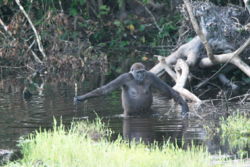Human Aquatic Adaptations
Notes:
- The diagram demonstrates the arguments proposed in the aquatic ape hypothesis (AAH) and related water-based models (e.g. the shore-based diet model), that swimming, diving, and a semi-aquatic lifestyle may have influenced human evolution, caused numerous adaptations in human morphology, anatomy and physiology.
- This diagram is a plain description of the hypothesis and does not provide any support nor criticism to the arguments.
- It must be noted that the points listed are not facts, but hypothetical claims that require further scientific investigations to verify their accuracy, falsifiability, and relevance to human evolution.
- The possible adaptations are grouped into aspects: swimming, floating, diving, foraging, walking, running, pregnancy, infancy, gender, sex, and a zoom-in of the head and the upper body.
- See File:Human_Aquatic_Adaptations_(extra).png or File:Human_Aquatic_Adaptations_(blue_extra).png for versions that includes a few unpublished ideas.
- See File:Human_Running_Adaptations.png for a similar summary of the endurance running hypothesis (ER).
Own work based on:
- Hardy AC (1960) Was man more aquatic in the past? New Scientist 17 Mar 7 (174): 642-645
- Morgan E (1982) The Aquatic Ape. Stein & Day Pub
- Morgan E (1990) The Scars of Evolution. Souvenir Press
- Morgan E (1997) The Aquatic Ape Hypothesis. Penguin
- Roede M, Wind J, Patrick J, Reynolds V (eds.) (1991) Aquatic Ape: Fact or Fiction? Souvenir Press
- Vaneechoutte M, Kuliukas AV, Verhaegen M (eds.) (2011) Was Man More Aquatic in the Past? Fifty Years After Alister Hardy - Waterside Hypothesis of Human Evolution. Bentham Science Publishers
- Cunnane SC, Stewart KM (eds.) (2010) Human Brain Evolution: The Influence of Freshwater and Marine Food Resources. Wiley-Blackwell
- Niemitz C (2010) The evolution of the upright posture and gait – a review and a new synthesis. Die Naturwissenschaften 97 (3): 241-263
- Odent M (1996) We are All Water Babies. Celestial Arts
- Verhaegen M et al.: various publications in Medical Hypotheses (1985, 1987), Nutrition and Health (1993), Ecology Research Progress (2007)
Relevantní obrázky
Relevantní články
Hypotéza vodní opiceHypotéza vodní opice je alternativní vysvětlení některých rozdílů mezi člověkem a ostatními hominidy, které pracuje s myšlenkou, že společný předek dnešních lidí strávil část vývoje v částečně vodním prostředí. Poprvé byla hypotéza navržena v roce 1942 a rozšířena v roce 1960; jejím největším obhájcem je spisovatelka Elaine Morganová. .. pokračovat ve čtení
BipedieBipedie znamená pohyb po dvou končetinách. Rozlišuje se habituální a příležitostná bipedie, například u šimpanze nebo medvěda. .. pokračovat ve čtení














